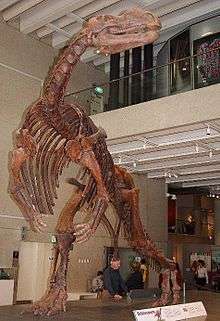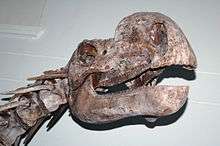Muttaburrasaurus
| Muttaburrasaurus Temporal range: Early Cretaceous,[1] 106 Ma | |
|---|---|
 | |
| Skeleton at the Queensland Museum | |
| Scientific classification | |
| Kingdom: | Animalia |
| Phylum: | Chordata |
| Class: | Reptilia |
| Clade: | Dinosauria |
| Order: | †Ornithischia |
| Suborder: | †Ornithopoda |
| Family: | †Rhabdodontidae |
| Genus: | †Muttaburrasaurus Bartholomai & Molnar, 1981 |
| Species: | †M. langdoni |
| Binomial name | |
| Muttaburrasaurus langdoni Bartholomai & Molnar, 1981 | |
Muttaburrasaurus was a genus of herbivorous ornithopod dinosaur, which lived in what is now northeastern Australia sometime between 112 and 99.6 million years ago[1] during the early Cretaceous Period. It has been recovered in some analyses as a member of the iguanodontian family Rhabdodontidae.[2] After Kunbarrasaurus, it is Australia's most completely known dinosaur from skeletal remains. It was named after Muttaburra, the site in Queensland, Australia, where it was found.
Discovery and species


The species was initially described from a partial skeleton found by grazier Doug Langdon in 1963 at Rosebery Downs Station beside Thomson River near Muttaburra, Queensland, Australia, which also provides the creature's generic name. The remains were collected by paleontologist Dr Alan Bartholomai and entomologist Edward Dahms. After a lengthy preparation of the fossils, it was named in 1981 by Bartholomai and Ralph Molnar, who honoured its discoverer with its specific name langdoni.[3]
The holotype, specimen QM F6140, was found in the Mackunda Formation dating to the Albian-Cenomanian. It consists of a partial skeleton with skull and lower jaws. The underside of the skull and the back of the mandibula, numerous vertebrae, parts of the pelvis, and parts of the front and hind limbs have been preserved.
Some teeth have been discovered further north, near Hughenden,[4] and south at Lightning Ridge,[4] in northwestern New South Wales. At Lightning Ridge there have been found opalised teeth and a scapula that may be from a Muttaburrasaurus. A skull, known as the "Dunluce Skull", specimen QM F14921, was discovered by John Stewart-Moore and 14-year-old Robert Walker on Dunluce Station, between Hughenden and Richmond in 1987. It originates from somewhat older layers of the Allaru Mudstone and was considered by Molnar to be a separate, yet unnamed species, a Muttaburrasaurus sp.[4] The same area produced two fragmentary skeletons in 1989. There have also been isolated teeth and bones found at Iona Station southeast of Hughenden.
Paleobiology
Muttaburrasaurus was about 8 metres (26 ft) and weighed around 2.8 metric tons (3.1 short tons).[5] The femur of the holotype has a length of 1015 millimetres.
Whether Muttaburrasaurus is capable of quadrupedal movement has been debated; it was originally thought to be an "Iguanodontid"; thought recent studies indicate a rhabdodont position. Ornithopods this basal were incapable of quadrupedal movement. Originally reconstructing Muttaburrasaurus with a thumb spike, Molnar later doubted such a structure was present.[4] The foot was long and broad, with four toes.
The skull of Muttaburrasaurus was rather flat, with a triangular cross-section seen from above, the back of the head being broad but the snout pointed. The snout had the form of a strongly enlarged, hollow, upward-bulging nasal muzzle that might have been used to produce distinctive calls or for display purposes. However, as no fossilised nasal tissue has been found, this remains conjectural. This so-called bulla nasalis was shorter with the older Muttaburrasaurus sp., as is shown by the Dunluce Skull. The top section of the bulla of the holotype has not been preserved, but at least the second skull has a rounded profile.[4]
Muttaburrasaurus had very powerful jaws equipped with shearing teeth. Whereas in more derived euornithopod species the replacement teeth alternated with the previous tooth generation to form a tooth battery, with Muttaburrasaurus they grew directly under them and only a single erupted generation was present. This precluded a chewing motion. An additional basal trait was the lack of a primary ridge on the teeth sides, showing eleven lower ridges. In 1981 Molnar speculated that these qualities indicated an omnivorous diet, Muttaburrasaurus at times eating carcasses. In 1995 he changed his opinion, presenting them as a convergence to the ceratopsian shearing teeth system. They would have been an adaptation for eating tough vegetation such as cycads.[6]
Phylogeny
Molnar originally assigned Muttaburrasaurus to the Iguanodontidae. Later authors suggested more basal euornithopod groups such as the Camptosauridae, Dryosauridae or Hypsilophodontidae. Studies by Andrew McDonald indicate a position in the Rhabdodontidae.[7][8]

Reconstructed skeleton casts
Reconstructed skeleton casts of Muttaburrasaurus, sponsored by Kellogg Company, have been put on display at a number of museums, including the Queensland Museum, Flinders Discovery Centre, and National Dinosaur Museum in Australia.
References
- 1 2 Holtz, Thomas R. Jr. (2012) Dinosaurs: The Most Complete, Up-to-Date Encyclopedia for Dinosaur Lovers of All Ages, Winter 2011 Appendix.
- ↑ McDonald, A.T.; Kirkland, J.I.; DeBlieux, D.D.; Madsen, S.K.; Cavin, J.; Milner, A.R.C.; Panzarin, L. (2010). "New Basal Iguanodonts from the Cedar Mountain Formation of Utah and the Evolution of Thumb-Spiked Dinosaurs". PLoS ONE. 5 (11): e14075. doi:10.1371/journal.pone.0014075. PMC 2989904
 . PMID 21124919.
. PMID 21124919. - ↑ Bartholomai, A; Molnar, R.E. (1981). "Muttaburrasaurus: a new Iguanodontid (Ornithischia:Ornithopoda) dinosaur from the Lower Cretaceous of Queensland". Memoirs of the Queensland Museum. 20 (2): 319–349.
- 1 2 3 4 5 Molnar, R.E. (1996). "Observations on the Australian ornithopod dinosaur, Muttaburrasaurus".". Memoirs of the Queensland Museum. 39 (3): 639–652.
- ↑ Paul, G.S. (2010). The Princeton Field Guide to Dinosaurs, Princeton University Press, p. 286.
- ↑ Molnar, R.E., 1995, "Possible convergence in the jaw mechanisms of ceratopians and Muttaburrasaurus". In: A.Sun and Y.Wang (eds) Sixth Symposium on Mesozoic Terrestrial Ecosystems and Biota, short papers. China Ocean Press, Beijing. pp.115-117
- ↑ McDonald AT, Kirkland JI, DeBlieux DD, Madsen SK, Cavin J, et al. (2010). "New Basal Iguanodonts from the Cedar Mountain Formation of Utah and the Evolution of Thumb-Spiked Dinosaurs.". PLoS ONE. 5 (11): e14075. doi:10.1371/journal.pone.0014075. PMC 2989904
 . PMID 21124919.
. PMID 21124919. - ↑ McDonald, A. T. (2012). Farke, Andrew A, ed. "Phylogeny of Basal Iguanodonts (Dinosauria: Ornithischia): An Update". PLoS ONE. 7 (5): e36745. doi:10.1371/journal.pone.0036745. PMC 3358318
 . PMID 22629328.
. PMID 22629328.
- Cannon, Libby (2006). "The Muttaburra Lizard". Australian Age of Dinosaurs (4): 16–31.
External links
- Australian Age of Dinosaurs
- Muttaburrasaurus langdoni, from Dann's Dinosaurs. (article)